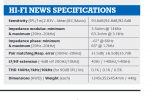Please Note: If used with a BTL amplifier, never try to use an oscilloscope to measure the peak power, as scopes are always grounded for safety. Connecting a grounded oscilloscope may cause amplifier failure, and may also damage the oscilloscope and/ or the scope lead. If you have a differential probe that provides total isolation that may be used, but few hobbyists will have one as they are very expensive.
BTL Amplifiers
There are some special precautions that you must be aware of before using the power meter with a BTL (bridge-tied load) power amp. Because both outputs carry a signal, you must not connect an oscilloscope, because the ground clip will place a short on one amplifier output! You can't use a transformer to couple the instantaneous power output to an oscilloscope either, because the output is 'unipolar' (of one polarity) and it basically carries a continuously varying DC offset. While a 1:1 transformer could (in theory) be capacitively coupled, the output as displayed on a scope would be extremely difficult to interpret.
It is possible to provide an optically coupled output that will perform to DC, but that's not a simple undertaking. It is something that I may look into further at some point (I've already done some research and there are several solutions, some better than others). You can buy a complete isolated amplifier, but the cost is considerable. Analog Devices make one, the AD215AY Isolation Amplifier, in a 12-Pin SIP (single inline pin) package, but at almost AU$150 each (at the time of writing) that's probably not something that most people will be prepared to purchase.
So, if you do need to test with a BTL amplifier, you'll be able to read the average power on a meter, but looking at the peak power isn't a viable option. Since the idea is primarily to characterise loudspeakers rather than amplifiers, use a 'conventional' power amp so there are no problems examining the peak output. Using a BTL amplifier that doesn't allow you to measure the peak voltage and current on an oscilloscope is very limiting.
Thats of course an problem,it seems it is not so easy using an ociloscope on an BTL Ampifier.
Most Icepower Amps are BTL Amps even if they have two channels . Couse of this icepower Amplifiers can not be bridged couse they are running in BTL Mode.
This has some advantages ans some disatvantages.
You dont need an DC Blocking Capacitor for example. And with an one channel am the smsps is not pumping.


